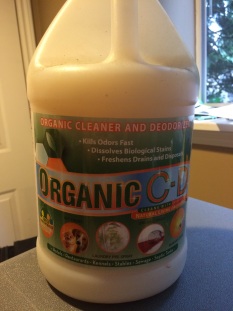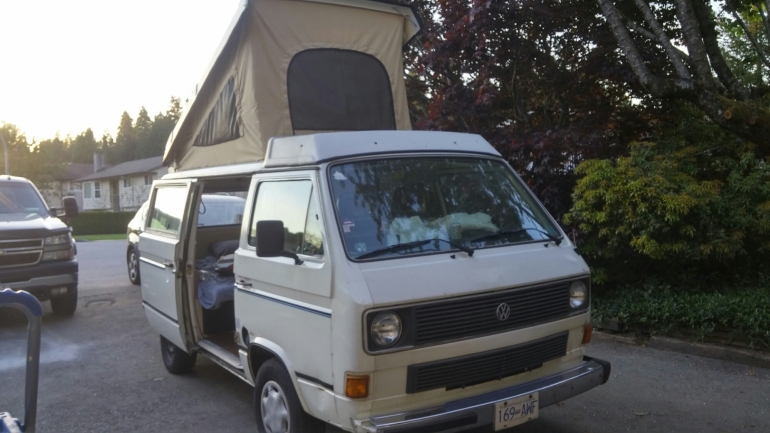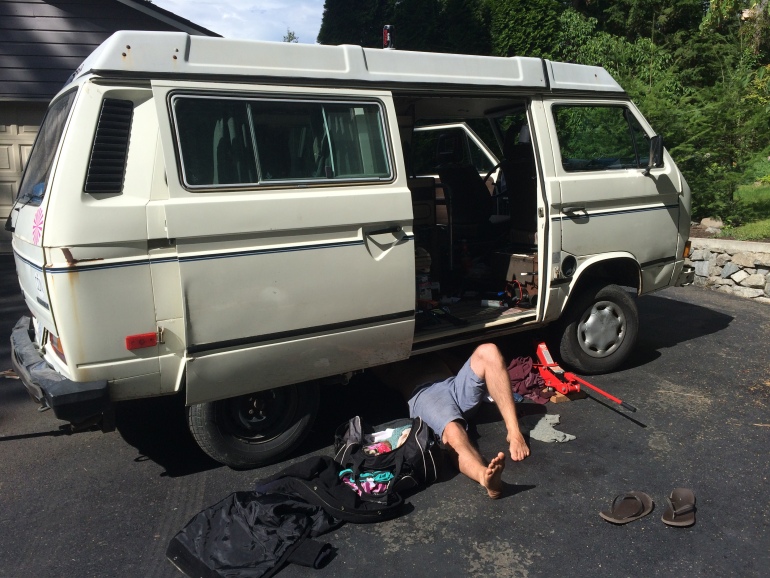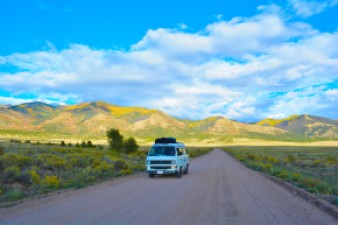Tools Needed:
- Tarp or Painters sheet
- Scrubbing brush
- Wirehead tooth brush
- Bleach spray
- Old rags (will get bleach stains)
- Spray bottles x2
- Bucket of water
- Heavy-duty cleaner (try Organic CD – the product we used for awesome results)
Difficulty – 1.5/5
Time Needed – 2-4 Hours
When we bought our Westfalia she was definitely showing her years, especially on her pop top ceiling. We discovered that it was a common problem among all these aging vehicles. Nearly everyone we’ve seen has a mould-covered canvas and ceiling. If you are going to spend any amount of time in your van you are going to want to remedy this issue. Mould can have serious negative effects on your health.
First, we covered the entire floor and kitchen area with a tarp (or painter’s sheet) to ensure nothing dripped onto our carpets.
The ceiling will have a natural “fuzzy” feel to it. Volkswagen added flocking on to help insulate the bus – you’re going to want to try to preserve this!
We started scrubbing with just vinegar water but with little results. When this didn’t work we then turned to a more heavy-duty cleaner. We found a new to Canada product called Organic C-D at a 2:1 ratio (two parts organic CD to one part water). This is an environmentally friendly product that utilizes bacteria to fight dirt and, in our case, mould.
This worked to get most of the black mould off our roof but missed a few areas. The mixture we found worked the best was a combination of bleach and water. We heavily diluted the solution and only used it for areas that our second mixture couldn’t handle.
Don’t forget to check out how we find the best FREE campsites!
Be careful when using bleach. We strongly recommend waiting for a clear sunny day so you can open all of your windows, doors and hatch. The fumes can quickly build up, especially if you are doing this with your canvas still attached. It is not good to breathe these vapours and can harm your lungs. If you have construction masks you may want to use them.
We had two spray bottles to test which concentrate worked better but quickly found that combining the two worked best.
Next, thoroughly soaked the roof in a spray of the Organic C-D mixture and bleach when needed.
The bleach will make your eyes sting a bit. Stick with it the results are amazing! After spraying both on we used our scrubbing brush (and some newfound muscles) to scrub the pop-top. Be careful not to use a too intense scrubbing brush that will chip away your flocking.
Be sure to avoid spraying your canvas with bleach – the stains on it would be awful! We found it best to break into sections then spray, scrub and then take a wet cloth to wipe away as much as you can. The corners are difficult – try using a toothbrush to get into them so you can be sure to kill all of the mould.
Please whatever you do, don’t just paint the ceiling white – This may sound like common sense but you wouldn’t believe how many Westys we have found that instead of cleaning their pop-top they simply spray painted their interior ceiling. This is horrible because it will just flake off which will still be toxic to you, not to mention it looks ugly.
Once you are finished, be sure to leave your windows open for at least a day to let it all ventilate so you aren’t left with a bleach sent!
Pro tip: if you’re changing out your canvas as well it will be MUCH easier to remove your old canvas and then clean the pop top. But make sure you clean it before installing the new one. This is a messy job and you don’t want to get your new canvas dirty or covered in bleach.
Let us know if you have any other tips or tricks to get this job done in the comments or if you have any photos, we love seeing them!
Happy cleaning 🙂














 As the water we use ends up in the earth we all live from, we spend a bit more to buy fully biodegradable soap. With multi functions, we use this soap for everything from dishes to laundry to a body wash (it is magic).
As the water we use ends up in the earth we all live from, we spend a bit more to buy fully biodegradable soap. With multi functions, we use this soap for everything from dishes to laundry to a body wash (it is magic). Something else changed though, this no longer seems like a chore that is not worth our time. Learning how to work together, Myles cooks and I do dishes and he puts them away. I wash laundry and he hangs the line and the clothes. We got into our respective routines quite quickly. A step back in time, we even use matches to start our propane stove instead of a simple lighter.
Something else changed though, this no longer seems like a chore that is not worth our time. Learning how to work together, Myles cooks and I do dishes and he puts them away. I wash laundry and he hangs the line and the clothes. We got into our respective routines quite quickly. A step back in time, we even use matches to start our propane stove instead of a simple lighter.





 After an intense love affair with Colorado (for anyone who hasn’t gone, go and allow yourself at least double the time you intend to stay there, it is AMAZING), Myles and I headed north toward Wyoming. We were told by quite a few people that Wyoming was home to some of the most beautiful and ever changing scenery. After crossing the border and instantly finding some hot springs, a new found favourite activity of ours, we were very happy to be there.
After an intense love affair with Colorado (for anyone who hasn’t gone, go and allow yourself at least double the time you intend to stay there, it is AMAZING), Myles and I headed north toward Wyoming. We were told by quite a few people that Wyoming was home to some of the most beautiful and ever changing scenery. After crossing the border and instantly finding some hot springs, a new found favourite activity of ours, we were very happy to be there.
 found that changing a little bit can make a huge difference. I am the first to admit I have lived (and still live) by them all. I’ve cut the sugar, stopped eating animals, have owned a juicer (really expensive – I would way rather eat my fruits and veggies) and really try to stick to non-steroid induced foods (ha-in our society!).
found that changing a little bit can make a huge difference. I am the first to admit I have lived (and still live) by them all. I’ve cut the sugar, stopped eating animals, have owned a juicer (really expensive – I would way rather eat my fruits and veggies) and really try to stick to non-steroid induced foods (ha-in our society!). with, “Oh no, how are you going to work?” That was probably my rock bottom, my hate all with society, my burning desire to make a change – a big change.
with, “Oh no, how are you going to work?” That was probably my rock bottom, my hate all with society, my burning desire to make a change – a big change.  surprised by this as everyone in my family has had issues with their gall bladder and has gotten theirs removed.
surprised by this as everyone in my family has had issues with their gall bladder and has gotten theirs removed. 
